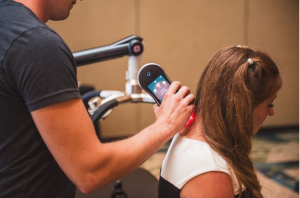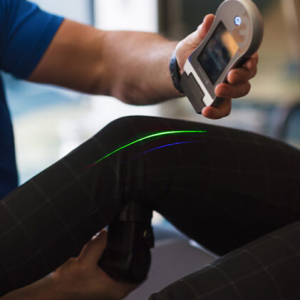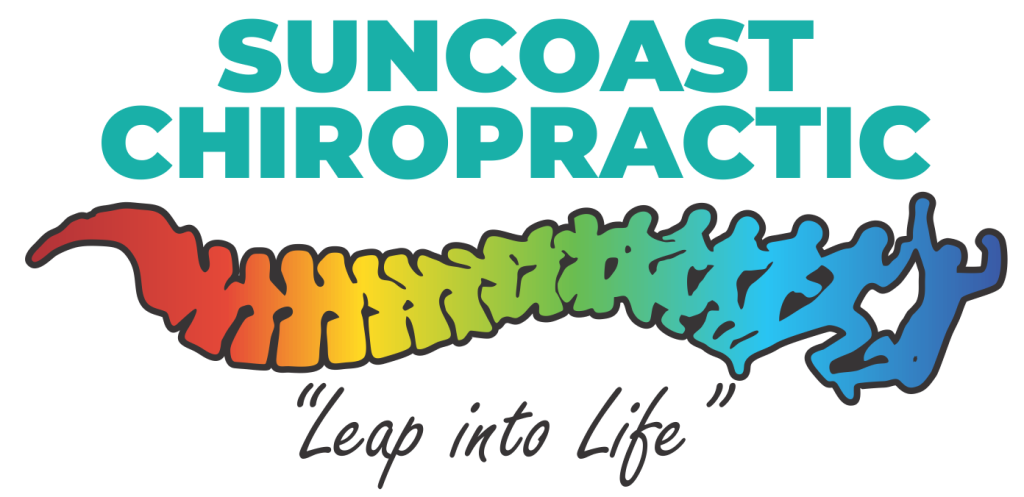In today’s fast-paced world, we’re constantly seeking safer, more efficient ways to heal our bodies. One treatment that’s rapidly gaining recognition in both clinical and wellness communities is Low-Level Laser Therapy (LLLT)—also known as cold laser therapy. Unlike surgical lasers that cut or burn tissue, LLLT stimulates cellular function to promote healing, reduce inflammation, and relieve pain—all without invasive procedures or downtime.
 What Is Low-Level Laser Therapy?
What Is Low-Level Laser Therapy?
LLLT uses specific wavelengths of light—typically red / green / violet or near-infrared—to penetrate the skin and interact with tissue at the cellular level. This light energy is absorbed by mitochondria (the powerhouse of the cell), boosting ATP production and enhancing cell repair, regeneration, and intra-cellular function.
How It Works:
- Light photons penetrate the skin
- They are absorbed by chromophores (a chromophore is the part of a cell or molecule that absorbs light) within the cells
- This activates a series of biological processes including improved blood flow, reduced oxidative stress, and increased cellular energy
Top Benefits of Low-Level Laser Therapy
- Pain Relief
LLLT can effectively reduce both acute and chronic pain. It’s commonly used for:
- Arthritis and joint pain
- Back and neck pain
- Carpal tunnel syndrome
- Tendonitis and bursitis
It helps by reducing inflammation, improving circulation, and stimulating nerve repair—providing natural, drug-free pain relief.
- Accelerated Tissue Repair and Healing
Whether you’re healing from a sports injury, surgery, or everyday wear and tear, LLLT can speed up the body’s natural healing process. It promotes:
- Faster wound healing
- Quicker muscle and ligament recovery
- Reduced scar tissue formation
- Reduced Inflammation and Swelling
LLLT helps reduce pro-inflammatory markers and promotes anti-inflammatory responses at the cellular level, making it ideal for managing chronic inflammatory conditions.
- Improved Circulation and Lymphatic Flow
The therapy enhances blood flow and oxygen delivery to tissues, while also aiding in the removal of toxins and waste products through improved lymphatic drainage.
- Safe, Non-Invasive, and Drug-Free
One of the biggest appeals of LLLT is that it’s painless, non-invasive, and carries virtually no side effects. It’s also a great option for people who want to avoid medications or invasive treatments.
 Common Applications of LLLT
Common Applications of LLLT
- Sports injuries and rehabilitation
- Chronic pain management
- Skin rejuvenation and wound healing
- Dental pain and TMJ disorders
- Neuropathy
- Hair loss (androgenic alopecia)
- Post-surgical healing
Who Can Benefit from LLLT?
Almost anyone experiencing pain, inflammation, or slow-healing injuries can benefit from LLLT. It’s especially useful for:
- Athletes looking for faster recovery
- Older adults with degenerative joint issues
- Pre and Post-surgical patients
- People with chronic pain or autoimmune conditions
Final Thoughts
Low-Level Laser Therapy is a powerful tool in modern health and wellness. By harnessing the natural healing capabilities of light, it offers a safe, effective, and drug-free alternative for many common health issues. Whether you’re recovering from an injury, dealing with chronic pain, or simply looking to optimize your body’s healing response, LLLT might be the non-invasive solution you’ve been looking for.
RESEARCH
Pain Management
Evaluation of Low-Level Laser Therapy at 635nm for the Treatment of Acute and Chronic Neck and Shoulder Pain: A Placebo-Controlled, Randomized Study
Laser in Surgery Medicine 2014, Volume 46, Number S25, March 2014 Ryan Maloney, Steven Shanks
Phoenix, AZ; Erchonia Corporation, McKinney, TX
Low-Level Laser Therapy for the Treatment of Chronic Neck and Shoulder Pain
Funct Neurol Rehabil Ergon 2016;6(2):97-104
Gregory C. Roche; Daniel J. Murphy; Trevor S. Berry; Steven Shanks
Effects of a Single Treatment with Two Non-Thermal Wavelengths on Chronic Neck and Shoulder Pain
Dove Press Journal, Medical Devices: Evidence and Research 2019:12 319–325
Robert G. Silverman, Albert Comey, Travis Sammons
A Randomized, Double-Blind, Sham-Controlled Study Evaluating the Effectiveness of a Low-level Laser Device for Treating Lower Back Pain
eMedical Research, Volume 2, Article ID: 100005
Trevor S. Berry, Paul J. Quarneri, Gregory Roche and Travis M. Sammons
Low-Level Laser Therapy for Treating Low Back Pain: 12-Month Follow-Up
Journal of Pain & Relief 2019, Volume 9, Issue 1
Trevor S. Berry, Paul J. Quarneri, Gregory Roche, and Travis M. Sammons
Low-Level Laser Therapy at 635 nm for Treatment of Chronic Plantar Fasciitis: A Placebo-Controlled, Randomized Study
Journal of Pain & Relief 2019, Volume 9, Issue 1
David M. Macias, Michael J. Coughlin, Kerry Zang, Faustin R. Stevens, James R. Jastifer, Jesse F. Doty
Two Randomized, Double Blind, Placebo-Controlled Trials Evaluating the Efficacy of Red 635nm Low Level Laser for the Treatment of Low Back Pain
The Journal of Foot & Ankle Surgery
Trevor S. Berry, Paul J. Quarneri, Travis M. Sammons, and Steve Shanks
Efficacy of 635nm Red Low-Level Laser on Nociceptive Musculoskeletal Pain Compared to NSAIDS, Opioids, and Other Light Sources
Orthopedics and Rheumatology Open Access Journal ISSN: 2471-6804
Jacob Januskewski, Chris Bromley, Cesar A Lara, Kirk Gair, Brandon Brock, Leonid Polishuk, and Travis Sammons
Low-Level Laser Therapy for the Treatment of Chronic Plantar Fasciitis
A Prospective Study
Foot & Ankle International
Volume 24. Number 4. April 2014
James R. Jastifer, MD, Fernanda Catena, MD, Jesse F. Doty, MD, Faustin Stevens, MD, Michael J. Coughlin, MD
Assessing the Impact of High Photon Energy Wavelengths on the Treatment of Chronic Neck and Shoulder Pain
Evidence-Based Complementary and Alternative Medicine, Volume 2023, Article ID 6672019, 9 pages
Travis Sammons, Kirk Gair, Robert G. Silverman, and Steve Shanks
Post Op
Low-Level Laser-Assisted Liposuction: A 2004 Clinical Study of its Effectiveness for Enhancing Ease of Liposuction Procedures and and Facilitating the Recovery Process for Patients Undergoing Thigh, Hip, and Stomach Contouring
Robert F. Jackson, MD; Gregory Roche, DO; Kimberly J. Butterwick, MD; Douglas D. Dedo, MD; Kevin T. Slattery, MD
Low-Level Laser-Assisted Liposuction: the Neira 4 L Technique
Clinics in Plastic Surgery
Rodrigo Neira, MD*, Luiz Toledo, MD, Jose Arroyave, BSc, MSc, TEM, SEM, Efrain Solarte, Dr, Rer, Nat, MSc, Carolina Isaza, MO, MSc, Oscar Gutierrez, MD, MSc, William Criollo, BSc, MSc, Hugo Ramirez, VMD, MSc, Maria I. Gutierrez, MD, MSc, PhD, Clara L. Ortiz-Neira, MD
**This article shows lasers effect on fat cells.
Low Level Laser in Liposuction Results
Low-Level Laser Therapy Effectiveness for Reducing Pain After Breast Augmentation American Journal of Cosmetic Surgery Vol. 26, No. 3, 2009
Robert F. Jackson, MD; Gregory Roche, DO; Todd Mangione, DO
Body Contouring
A Double-Blind, Sham-Controlled Study Demonstrating the Effectiveness of Low-Level Laser Therapy Using a 532-nm Green Diode for Contouring the Waist, Hips, and Thighs Study Abstract
David P. Suarez, DO; Gregory C. Roche, MD, FACS; Robert F. Jackson, MD, FACS
Low-Level Laser Therapy as a Non-Invasive Approach for Body Contouring: A Randomized, Controlled Study Lasers in Surgery Medicine 41: 799-809 (2009)
Robert F. Jackson, MD; Joug D. Dedo, MD; Greg C. Roche, MD; David I. Turok, and Ryan J. Maloney
The Use of Low Level Laser Therapy for Noninvasive Body Contouring Aesthetic Medicine Art and Techniques
Robert F. Jackson, MD; Ryan J. Maloney
Low-Level Laser Therapy for Reducing the Hip, Waist, and Upper Abdomen Circumference of Individuals with Obesity
Photomedicine and Laser Surgery Volume 35, Number 3, 2017
Gregory C. Roche, DO, Steven Shanks, Robert F. Jackson, MD, and Laura Jane Holsey, DO
Dr. Neira Cosmetic Surgery 2001
Cellulite
A Double-Blind, Placebo-Controlled Randomized Trial Evaluating the Ability of Low-Level Laser Therapy to Improve the Appearance of Cellulite
Robert F. Jackson, MD, Gregory C. Roche, DO, and Steven Shanks
Onychomycosis
Erchonia Laser Therapy in the Treatment of Onychomycosis
A Preliminary Report on an Ongoing Clinical Trial
Podiatry Review Vol 71:2
Robert Sullivan and Deirdre O’Flynn
Clinical Director of Midleton Foot Clinic, Midleton, Ireland
Deirdre O’Flynn, Senior Associate, Midleton Foot Clinic
A Retrospective Study of Non-thermal Laser Therapy for the Treatment of Toenail Onychomycosis
Journal of Clinical and Aesthetic Dermatolgy
May 2017
Kerry Zang, DPM; Robert Sullivan, BSc (Hons) Podiatry, MSc Pod Surgery, PgCAcup, FIChPA, MInstChP; Steven Shanks
~Article available on JCAD online
Treatment of Toenail Onychomycosis using Laser Pharmacology
Arizona Institute of Footcare Physicians
Kerry Zang, Travis Sammons, Steve Shanks
